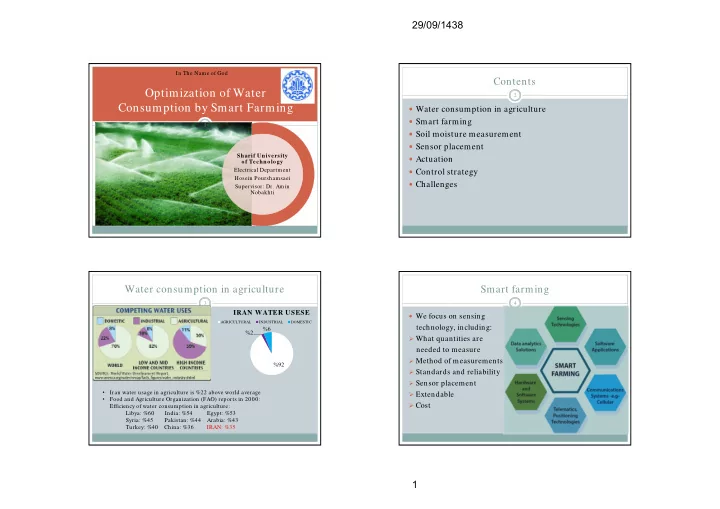

29/09/1438 In The Name of God Contents Optimization of Water 2 Consumption by Smart Farming Water consumption in agriculture Smart farming 1 Soil moisture measurement Sensor placement Sharif University Actuation of Technology Electrical Department Control strategy Hosein Pourshamsaei Challenges Supervisor: Dr. Amin Nobakhti Water consumption in agriculture Smart farming 3 4 IRAN WATER USESE We focus on sensing AGRICULTURAL INDUSTRIAL DOMESTIC technology, including: % 6 % 2 What quantities are needed to measure Method of measurements % 92 Standards and reliability Sensor placement • Iran water usage in agriculture is %22 above world average Extendable • Food and Agriculture Organization (FAO) reports in 2000: Cost Efficiency of water consumption in agriculture: Libya: %60 India: %54 Egypt: %53 Syria: %45 Pakistan: %44 Arabia: %43 Turkey: %40 China: %36 IRAN: %35 1
29/09/1438 Soil moisture measurement Soil water potential 5 6 Definitions: A difference in water potential between two soil locations indicates a tendency for water flow, from o Soil water content high to low potential. � ����� � � � � or � � � ����� � ���� � ���� Soil water potential describes the energy status of the soil water and is an important parameter for water o Soil water potential transport analysis, water storage estimates and Amount of work per unit quantity of pure water that watering time plan. must be done by external forces to transfer reversibly � and isothermally an infinitesimal amount of water ψ � � ψ � � ψ � � ψ � � ψ � � � � � from the standard state to the soil at the point under consideration. Soil water potential Soil water potential 7 8 � � - pressure potential � � m easurem ent � � � � � �� � Energy per unit volume of water required to transfer an infinitesimal quantity of water from a reference pool of water at the elevation of the soil to the point of interest in the soil at reference air pressure and temperature. If soil is saturated, ψ � is positive and If the soil is unsaturated, ψ � is negative. 2
29/09/1438 Soil water potential Soil water content measurement methods 9 10 � � - gravitational potential Direct method Energy per unit volume of water required to move an water content may be determined indirectly by infinitesimal amount of pure, free water from the various radiological techniques, such as neutron reference elevation ( � � ) to the soil water elevation scattering and gamma absorption ( � ���� ). Soil water dielectrics: � � - solute potential permittivity or “dielectric constant”, always negative since defined relative to pure water. is for liquid water about 20 times � � - air pressure potential larger than that of average dry soil, Accounts for changes in air pressure, different than the because water molecules are reference pressure (atmospheric pressure). permanent dipoles. Soil water dielectrics Soil water content or potential? 11 12 Soil water content measurement has lower cost For sprinkle watering soil water content is better. For pipe watering water potential is better For a specific soil, both are equivalent: 3
29/09/1438 Sensors placement Actuation 13 14 Finding optimal sensors number and placement is Possible actuators: important, since: o Human! Cost constraints o Solenoid valves on pipe paths Maintenance issues o Sprinkles Precision: sensors must be placed in a typical spot, no wettest or driest Control strategy Challenges 15 16 Daily watering: Cost o Selecting each day of the week for watering to occur. Sensor placement the total run time should be split up among several Reliability and maintenance start times. For example twenty minutes a day could Agricultural knowledge be programmed to be four start times for five minutes each. o Schedule at least one hour of time between cycle starts. Programmed days: o irrigation can take place only on selected days or hours. 4
29/09/1438 5 17
Recommend
More recommend